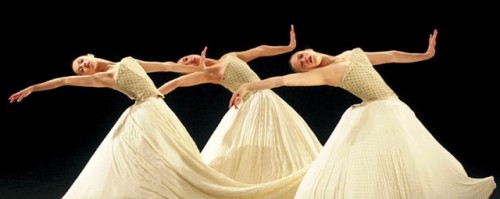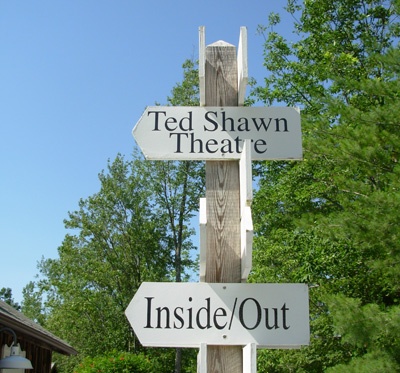Tania Perez-Salas
Mexican Company Sizzles
By: - Aug 16, 2006
Tania Perez-Salas
Compania de Danza
Ted Shawn Theatre
July 12-16, 2006
Jacob's Pillow Dance
Becket, Mass
www.jacobspillow.org.
413 243 0745
Tania Perez-Salas, choreography, artistic and executive director
Dancers: Tzitzi Benavides, Carlos Carrillo, Jonathan Castro, Aoi Funakoshi, Arturo Garcia, Katherine Horrigan, Angela Luem-Dimas, Emir Meza, Carolina Patino, Kristin Taylor
The Hours, 2001
Inspired by Allessandro Baricco's Oceana Mare and The Hours by Michael Cunningham
Music: Vivaldi, The Four Seasons, Lully, The Little Motets, Vivaldi, Juditha Triumphans, Concerto in G minor for Two Cellos, Goran Bregovic, Wedding
Anabiosis, 2000, U.S, Premiere
Inspired by Octavio Paz, Love and Eroticism: The Double Flame
Music: Tykwer, Klimek and Reimhold Heil, Running To, Handel, Concerti Grossi Op.3 and 4, Bach, Suite no.6, Saafi Brothers, mystical chants
Waters of Forgetfulness, 1998, U.S. Premiere
Inspired by Ivan Illich's essay H2O and the Waters of Forgetfulness
Music: Arvo Part, Tabula Rasa, M. Danna, Expulsion, A cry from the Heart, and Markings, Stoa, Bene est viro qui
By Charles Giuliano
In only the second United States appearance by Mexico's Compania de Danza, choreographer Tania Perez-Salas stunned and electrified the audience at Jacob's Pillow Dance with a sensual program of three narrative works, including two U.S. premieres, this past weekend. As one of the nation's foremost dance programs and summer long festivals the Pillow is know for combining established and emerging companies as well as a rich and varied series of free performances featuring experimental work. We come to expect excellence but here the Pillow went beyond the beyond. Wow.
Based on the 2002 film with the theme of suicide in the lives of three women, we know that Nicole Kidman, sporting a putty nose for the part, would famously drown as Virginia Woolf, the British novelist. The Hours begins with a woman seemingly entrapped in a large, slowly rotating clock, a metaphor for the passage of time. There are other literal references to water both projected and a fluttering curtain. A single dancer rises and brings with her an enormous hoped skirt. With a flip, underneath emerges a trio of women configured into one large skirt which is a device than both joins, binds and energizes them. Their dance is witty and at times comic. They vary from synchronized movements to others in which they bump and jostle in a playful manner that serves as a metaphor for their relationship.
The music, which was consistent with the three pieces presented here, is a collage of elements. Perez-Salas is particularly concerned with costuming and stagecraft with an emphasis on light and textures. While there are inventive, multi media and prop elements they seem well matched with the mood and intent of the dance and the advance of narrative content. The Hours climaxes when several ropes are dropped from above the stage (recalling the Sankai Juku company which works with ropes in a rather different context). The female dancers climb and entwine them about their bodies. This sequence evokes the movement of the author whirling about in the stream in the process of drowning. Eventually the dancers collapse horizontally in a shocking and insightful stoppage of both life and time. On every level it is the end of the dance but it lingers with us after the curtain is drawn. In that sense her dance is both literal and poetic.
The second piece Anabiosis is also concerned with states of life and death but here the process is about the restoration to life from a state of suspension or reanimation. To a disco/techno beat a single dancer is lying on the stage jerking and contorting as though coming out of a deep trauma. Where women dominated The Hours, here the male dancers play a more prominent role as Perez-Salas's choreography explores the erotic and aspects of physical love. In this second piece one became more aware of the eclectic technique and body types of the company. Few if any possess the bodies of classic ballet. And their style, in keeping with the eclectic collage of music, is balletic/ modern with inventive movements. No particular dancer attracts our attention as we are more aware of the ensemble and how they work together. In that sense Perez-Salas's choreography is richly inventive and intricate but does not emphasize solos or spectacular athleticism. Everything works to advance the narrative.
While The Hours was unique, powerful and memorable, a stronger work overall than Anabiosis, Perez-Salas saved the best for last with the truly original and remarkable work Waters of Forgetfulness. On a dimly lit stage Perez-Salas gradually begins to move. We become aware that she is lying in shallow water covering the entire stage at about ankle depth. Abrupt movements cause splashes of water that form momentary arcs. She exits and is replaced by members of the company who expand on the vocabulary of how to evoke spontaneous splashes of water into the power and drama of the dance. One device is to have the women lean over and dangle their long hair in the water and then whip their heads back as an arch of water leaps into the air and fleetingly marks their movement. As we get engrossed in the vocabulary of movements and how to manipilate the sound and splash of water, we wonder just how she will work her way out of the limits of this device. Just as we seem to have absorbed and diagnosed her invention there is a sudden cascade of sand at the back of the set, followed by another and another in dramatic downpours. A surrogate, dry, waterfall. Yes, of course, we think, how perfect, how sublime. Exquisite. Just for a moment she has us suspended on the edge of reality. Unbelievable. It lingers and gets deep into you long after the performance is over. Won't let go. Like drowning in art. An afternoon of life and death in the Berkshires.


